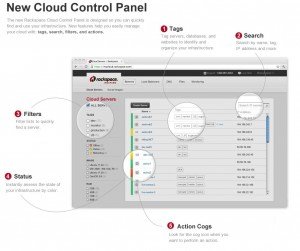For Rackspace, there’s no turning back from OpenStack now. As of Wednesday, all new customer workloads will deploy on the company’s open source cloud computing platform, leaving the company’s legacy platform for existing customers that want to take their time transitioning to the new cloud. Now, the competition to dethrone cloud king Amazon Web Services really begins. Or does it?
I recently spoke with Rackspace CEO Lanham Napier, who shared his vision for how OpenStack is changing his company from the inside out and how he doesn’t necessarily view Amazon as direct competitor.
On competing with Amazon

Rackspace’s new cloud control panel
Looking at the new Rackspace Cloud portfolio — which now includes computing, object storage, database, monitoring and a new control panel, and which will soon include software-defined networking and block storage capabilities — one can’t be faulted for assuming Rackspace is trying to go toe to toe with the feature-rich AWS. It’s even harder to shake the thought when you hear, as I did a couple months ago from Rackspace CTO John Engates, that the company is thinking about higher-level features such as managed Hadoop or NoSQL services.
But Napier insists that while all the features might be necessary to address customers’ needs, table stakes if you will, it’s not Rackspace’s goal to compete with Amazon for sheer number of developers or market revenue share. “AWS, in particular, is playing a scale game,” he said, “We’re playing a different game.”
That game is about speed and performance — which OpenStack has let Rackspace improve upon significantly — and, most importantly, service. (If you’ve talked to a Rackspace employee, you’ve no doubt heard the spiel about the company’s trademarked (literally) “fanatical support.”). Napier said the recurring theme among customers that use Rackspace and competing clouds is that they use Rackspace for the things with which they want help and a truly managed experience.
There’s a large segment of cloud users that want to pay for peace of mind, he said, which is where Rackspace excels. It will always remain competitive on price, but it doesn’t expect to be the low-price leader. “If somebody want to … get the rock-bottom cheapest price, we believe there are better options than us.”
Still, Rackspace will have to concern itself with AWS, especially as it increasingly targets enterprise workloads with managed services, enhanced security and control, and, yes, lower prices. Now that it’s building technology rather than just assembling other companies’ tech, Rackspace also will have to concern itself with former partners, such as Microsoft and VMware, that are pushing their own public and private cloud agendas (Rackspace launched its Cloud Builders business last year to help customers deploy their own OpenStack clouds).
To that point, Napier joked, “We’re in an interesting, hyper-competitive time in tech. Maybe we need to launch a search engine.” However, he reiterated, customers care about service as well as technology. “What they’re really paying for is an incredible outcome.”
On competing with OpenStack partners
Aside from competitive cloud platforms, though, Rackspace also has to deal with the host of other OpenStack members, such as HP, Internap and Dell rolling out their own OpenStack-based public clouds. There’s also a small but growing group of startups building and selling their own OpenStack software, and the result has been a something like a revolving door of talent among companies — including out of Rackspace.
Napier thinks the movement of employees within the ecosystem is natural as it shapes up, and is just one of the tradeoffs Rackspace had to make in order to let OpenStack grow organically like a true open source project. “There’s going to be a lot of competition within the stack to figure out which platform gets the most traction,” he said. However, he noted, “as long as the community is advancing, we benefit from that.”
The bigger issue would be if the project began splintering like UNIX did in the 1990s and lost its opportunity to take on the proprietary incumbent providers. But, Napier said, everyone seems to be trying hard to ensure that doesn’t happen. (Well, everyone except Citrix, maybe.)
On becoming a new company

Lanham Napier
If it’s surprising to hear all this talk about cloud computing from the CEO of a company that still gets the majority of its revenue from managed hosting, you haven’t been paying attention. Rackspace’s cloud business has been growing far faster than its legacy hosting business and, Napier said, now accounts for between 20 and 25 percent of what should be roughly $1.2 billion in revenue this year. “I actually think that if you roll the tape forward just a few years, it’s going to be inverted,” he said.
And being a cloud provider first means big changes in how the company invests in technology, because technology now opens up new business models. For starters, Napier said, OpenStack has been Rackspace’s biggest software investment ever. Looking at its recent earnings, you’ll see the company has been spending about $15 million a quarter on “capitalized software and other projects” (more than it has been spending on data center build outs) and most of that is OpenStack.
While software spending is at an all-time high, though, Napier expects Rackspace’s hardware spending to drop pretty significantly in the coming years. In part, that’s because OpenStack, by design, allows it to do more with less and to invest in commodity gear instead of the branded gear that managed hosting customers prefer. Rackspace’s involvement in Facebook’s Open Compute Project, which is centered around ultra-efficient no-frills server and storage hardware, and the ARM-based TryStack cloud should also pay dividends in the form of ever less-expensive and more-efficient gear.
“As these projects gather more stream and momentum,” Napier said, “you’ll see our investment allocation skew more and more toward software.”